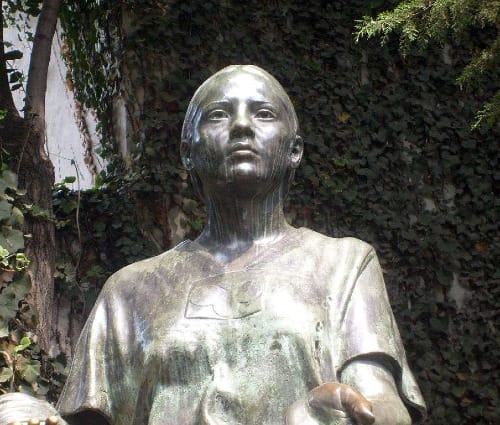A Tale of Two Women - Timeline

- 1499 Birth of Bernardino de Sahagún
- 1517 Martin Luther nails the 95 Theses to the church door in Wittenberg
- 1519 Cortés expedition arrives in Mexico (March 4)
- Charles (Carlos) of Spain becomes the Holy Roman Emperor as Charles V
- Death of Leonardo da Vinci
- 1520 Night of Sorrow (La Noche Triste ) in Tenochtitlán - Aztecs massacre Cortés’ troops and Indian allies.
- Smallpox epidemic decimates indigenous populations
- Death of Raphael
- 1521 Diet of Worms debates Luther’s challenge, hosted by Emperor Charles V, subsequently declaring Luther an outlaw and heretic. The Edict was not really enforced.
- Magellan killed in the Philippines
- Fall of Tenochtitlán; Spanish conquest of Mexico completed
- 1522 Birth of Martin Cortés, son of Malinche and Cortés
- 1527 Emperor Charles V sacks Rome
- 1528 Cortés returns to Spain; arrival of Zumárraga in New Spain
- 1529 Bernardino de Sahagún arrives in New Spain
- 1530 Cortés returns to Vera Cruz; peace returns to New Spain
- 1531 December: appearance of the Virgin of Guadalupe
- 1532 Bishop-elect Zumárraga sets sail for Spain
- 1533 The Spaniards erect the first sanctuary to Guadalupe
- 1537 The Pope had declares that the Indians are rational beings with souls and their lives and property are to be protected
- 1538 Smallpox epidemic in Mexico
- 1540 Cortés returns to Spain for the last time
- 1545 Typhus epidemic
- 1548 Death of Bishop Zumárraga and Martin Cortés
- First possible evidence of the Guadalupe apparition: this is an estimated date for the publication of the Codex Escalada, a pictographic account of the appearance of the Virgin. Early oral histories may push the date back as far as 1531 but most historians believe the first written accounts appeared a century later. Believers argue that the Nican Mopohua (see 1648) dates back to this time.
- 1550 Valladolid Controversy over whether the Indians should be treated as humans (the view of Father Bartolomé de Las Casas) or as slaves of nature (the view of Juan Ginés de Sepúlveda).
- 1551/2 Possible death of la Malinche
- 1552 Bartolomé de Las Casas’ A Short Account of the Destruction of the Indies (Brevísima relación de la destrucción de las Indias) published.
- 1555 The second archbishop of Mexico, Alonso de Montúfar, formalizes the process of approving the Guadalupe apparitions. The first major expansion of the Church of Guadalupe was undertaken the following year.
- 1569 First official denunciation of the “cult” of the Virgin of Guadalupe by the Fourth Viceroy of Mexico, Martin Enriquez de Almanza
- 1571 Arrival in Mexico of the Spanish Inquisition
- 1571 A painted copy of the Virgin of Guadalupe sailed with the Spanish navy in its victory over the Ottoman fleet at the Battle of Lepanto. Cervantes fought in the battle.
- 1577 Bernardino de Sahagún’s writings are finished in an initial draft now called The Florentine Codex, which is in 12 illustrated volumes. At the time it was reorganized for publication in 4 (or 12?) illustrated volumes, the Historia General de las Cosas de la Nueva España, and promptly confiscated by the Church. Some question whether that was bureaucracy as usual or outright paranoia over the contents. It would not be published until 1829 -- in Mexico.
- 1590 Death of Bernardino de Sahagún
- 1605 Part One of Don Quixote de la Mancha (El ingenioso hidalgo Don Quixote de la Mancha) is published in Madrid by Miguel de Cervantes Saavedra; Part Two was published in 1615, a year before Cervantes died
- 1622 The church of Our Lady of Guadalupe is relocated to the foot of Tepeyac hill.
- 1623-24 Peter Paul Rubens’ The Virgin as the Woman of the Apocalypse
- 1648-49 The first published accounts of the apparition of Guadalupe: possibly first in Spanish by Miguel Sánchez in Imagen de la Virgen Maria and subsequently in Nahuatl in Luis Laso de la Vega’s Huei tlamahuiçoltica, which includes the Nican Mopohua.
- 1695 New church of the Guadalupe built at the foot of Tepeyac
- 1737 The Catholic Church declares Guadalupe patron of Mexico
- 1848 Treaty of Guadalupe Hidalgo
- 1949 Kahlo paints “The Love Embrace of the Universe, the Earth (Mexico), Diego, Me and Senor Xolotl”
- 1950 Octavio Paz writes and publishes El laberinto de la soledad (“The Labyrinth of Solitude”)
- 1954 Death of Frida Kahlo
- 1966 Pope Paul VI presented to the shrine a golden rose, a symbol that has since been awarded to Lourdes and Fatima shrines.
- 1990 Pope John Paul II beatifies Juan Diego
- 1999 Pope John Paul II names the Virgin of Guadalupe patroness of all the Americas
